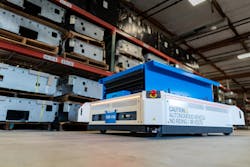Autonomous mobile robots have been gaining traction in industry for several years now. Often seen as a replacement for the automated guided vehicles (AGVs) used to automate material handling tasks, mobile robots offer the advantage of being able to navigate complex environments without the need for permanent wire strips or magnetic tracks along the floor to guide their path.
Since the onset of COVID-19, the adoption of mobile robots has swelled due to the robots’ ability to help meet social distancing requirements in industry verticals ranging from healthcare to manufacturing. Warehousing applications have seen an uptick in mobile robotics adoption as well, as homebound consumers ordering goods online has spiked demand for rapid order fulfillment at a time when fewer workers are able to occupy facilities.
Yet one major concern that still remains is safety, particularly as mobile robots see their payloads increasing. Until recently, no official safety standard had been devised.
The new standard
Enter R15.08 Part One, the first standard for mobile robot safety from the Robotics Industry Association (RIA). R15.08 has been in the works for over four years and was published late last year. The standard provides technical requirements for the design and integration of mobile robot bases equipped with manipulators such as robotic arms and other accessories.
According to Melonee Wise, CEO at Fetch Robotics, and a member of the R15.08 standard committee, R15.08 is a type-C standard, meaning it is specific to a particular technology, as opposed to type-A standards, which cover basic concepts and general design principles across all machinery, and type-B standards, which entail safety principles that can be used across a range of machinery within a certain category.
The type-C designation is noteworthy to end users for several reasons. Firstly, the development of type-C standards often signals a new stage in the maturity of an innovative product, and tends to be followed by more ubiquitous adoption. Fixed robotic arms and AGVs both followed this pattern, Wise says. Therefore, those with their eye on the space should expect deployment of mobile robots to accelerate underneath the new standard.
In addition, while legal compliance with type-C standards is not usually enforced by the Occupational Safety and Health Administration (OSHA), voluntary conformity may still be expected by the organization.
“One of the things that’s happened in a lot of cases in the U.S. with type-C standards is that, because it’s so hard to keep up with the technology, OSHA doesn’t enforce specific compliance. So, technically there is no robot standard that OSHA is [currently] enforcing, but they are saying it’s important to conform to these standards for worker safety,” Wise says. “Although these legal entities may not absolutely require these things, if you don’t conform, they can still say ‘look, these are the best practices, and you should be following them.’ In that case, you may still be cited or forced to pay a fine for gross negligence if you didn’t follow through with the prevailing standard.”
Updates and improvements
Previously, the American National Standards Institute (ANSI) had devised standard B56.6 for AGVs and R15.06 for fixed robotic arms. However, B56.6 only addresses vehicles that follow fixed guide paths and R15.06 does not consider robotic arms that have been integrated with mobile bases. By contrast, R15.08 is specifically tailored not just for mobile robots—both mobile robot bases designed to carry materials as well as those equipped with robotic arms, manipulators, and other peripheral accessories.
Accordingly, R15.08 is broken down into three sections: The AMR base, fixed robotic arms mounted on the base, and other mounted accessories such as tooling. Wise notes that this is a unique structure for a standard, but is necessary because mounting other parts on an AMR base can have a significant effect on performance.
“Because an arm or other accessory can impact things like sensing, driving, steerability, and stability, the person who makes that [robot], whether it’s an integrator or someone else, is essentially becoming a manufacturer,” Wise says. “So, this standard might present a difficult transition for some integrators who, in the past, have not had that level of responsibility for certifying or proving that they are in conformity with standards of this nature.”
Wise stresses that integrators looking to avoid being squeezed out of the market need to adapt to this increased expectation, as mobile robot customers will inevitably begin demanding conformity with the standard as it becomes more prevalent.
However, on the end-user side, there are only benefits to be had. According to Wise, R15.08 will make it faster and easier to deploy mobile robots without needing to conduct an independent safety assessment. This will result not only in cost reductions, but lower risk and liability for end-users.
Going forward, the R15.08 committee will be developing R15.08 Part Two, which will include expanded safety requirements for mobile robot systems and systems integration as well as safety requirements for mobile robot fleets. R15.08 Part Three will further expand safety requirements for end-users of mobile robots.

